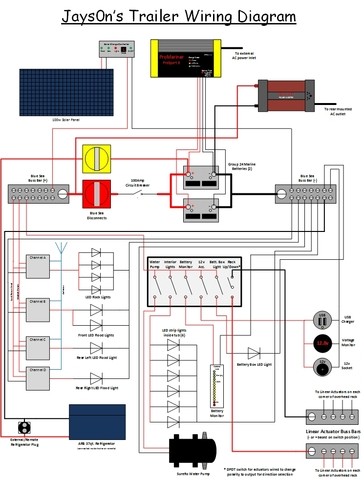You are using an out of date browser. It may not display this or other websites correctly.
You should upgrade or use an alternative browser.
You should upgrade or use an alternative browser.
Electrical system guidance needed...
- Thread starter FandL
- Start date
villageidiot327
Explorer
I think you need to begin with what your demands are, what equipment you will have and how much battery capacity you will need based on the items you will bring.
1. Figure out what you're putting on your rig. Lights, Inverter, vent fan, water pump, etc. Always go with LED lighting.
2. Determine the loads these will produce. How many Amps will you be drawing?
3. How long do you want your power to last? This will help determine how many AH you'll want out of your deep-cycle batteries.
4. Do you want to be able to recharge with solar? If so you'll need panels and charge controller.
5. Will you run AUX power from your tow vehicle? I did this for a small inverter keeping my fridge on 110v only while towing.
6. Draw a rough diagram of where your wires will run from and to. I used some 1/2" plastic hose as a conduit.
7. Pick a fuse block. I used this one. https://www.amazon.com/Blue-Sea-Sys...qid=1523376467&sr=8-4&keywords=12v+fuse+block
8. Get wire. Always use good "Primary wire". This is the stranded stuff. If you have a West Marine close by, they usually have a good stock of wire. Or you can order online.
9. When I wired, I connected the wires to my device(s) first and created wire bundle to run to the fuse panel from the light, fan, etc. This helps keep things neat and once you get all the wires to the fuse panel, you can cut to size do some good wire management.
10. Don't use cheap crimp connections. I used AMP PIDG connections. These double crimp the wire.
11. If at all possible, use some heat-shrink on your butt connections and terminal rings.
12. Don't use the trailer frame as a ground. Run negative wires back to your fuse block - then to the battery.
13. Never hook high-wattage inverters to the fuse block. Create a separate, fused run directly to the battery. If you want to put it on a switch, use a relay.
This should give you a good start.
2. Determine the loads these will produce. How many Amps will you be drawing?
3. How long do you want your power to last? This will help determine how many AH you'll want out of your deep-cycle batteries.
4. Do you want to be able to recharge with solar? If so you'll need panels and charge controller.
5. Will you run AUX power from your tow vehicle? I did this for a small inverter keeping my fridge on 110v only while towing.
6. Draw a rough diagram of where your wires will run from and to. I used some 1/2" plastic hose as a conduit.
7. Pick a fuse block. I used this one. https://www.amazon.com/Blue-Sea-Sys...qid=1523376467&sr=8-4&keywords=12v+fuse+block
8. Get wire. Always use good "Primary wire". This is the stranded stuff. If you have a West Marine close by, they usually have a good stock of wire. Or you can order online.
9. When I wired, I connected the wires to my device(s) first and created wire bundle to run to the fuse panel from the light, fan, etc. This helps keep things neat and once you get all the wires to the fuse panel, you can cut to size do some good wire management.
10. Don't use cheap crimp connections. I used AMP PIDG connections. These double crimp the wire.
11. If at all possible, use some heat-shrink on your butt connections and terminal rings.
12. Don't use the trailer frame as a ground. Run negative wires back to your fuse block - then to the battery.
13. Never hook high-wattage inverters to the fuse block. Create a separate, fused run directly to the battery. If you want to put it on a switch, use a relay.
This should give you a good start.
ottsville
Observer
I haven't looked through this thread, but it is one that I have bookmarked:
http://www.tnttt.com/viewtopic.php?f=30&t=1941&sid=3a10eda1102f9c30c2723f74ca894251
http://www.tnttt.com/viewtopic.php?f=30&t=1941&sid=3a10eda1102f9c30c2723f74ca894251
One other thought. I essentially have two electrical systems on my trailer.
1 - This is the internal electrical system that runs all my toys in the trailer. This is my lights, inverter, solar, etc.
2 - This is the external electrical system that controls the exterior lights, brakes, etc. and only draws it's power from your tow-vehicle. The only exception is the inverter for my fridge, this is run from the AUX power coming from my tow vehicle.
Same rules apply from above. Don't ground to the frame, good crimp connectors, etc.
1 - This is the internal electrical system that runs all my toys in the trailer. This is my lights, inverter, solar, etc.
2 - This is the external electrical system that controls the exterior lights, brakes, etc. and only draws it's power from your tow-vehicle. The only exception is the inverter for my fridge, this is run from the AUX power coming from my tow vehicle.
Same rules apply from above. Don't ground to the frame, good crimp connectors, etc.
s.e.charles
Well-known member
not the worst information I have ever received:
jays0n
Adventurer
That list is great advice and I took it even a bit further, I soldered and heat shrunk all connections including any terminals that were required. Below is the wiring diagram I put together for my trailer, it's not perfect but should give you some ideas. I currently don't have a charge lead from my tow vehicle to the trailer, I'll probably add that when I add electric brakes over the winter. Hope this helps!


Similar threads
- Replies
- 1
- Views
- 662
- Replies
- 0
- Views
- 3K
- Replies
- 0
- Views
- 133
